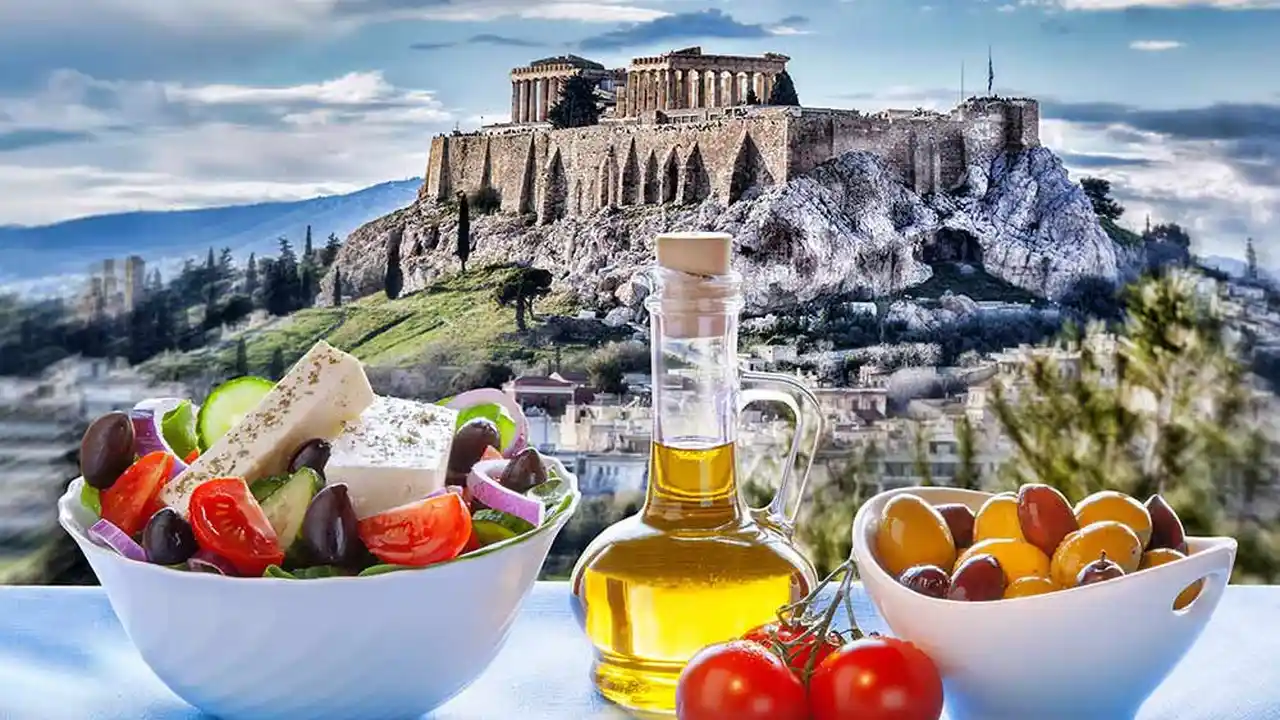Greek Cuisine: A US Traveler's Culinary Adventure
Sample meta description.

Discovering Authentic Greek Flavors A Culinary Journey for US Travelers
Embarking on a culinary adventure to Greece is a dream for many US travelers, and for good reason! Greek cuisine is a vibrant tapestry of flavors, textures, and aromas that tantalize the senses. Forget the souvlaki you find at your local Greek takeout; we're talking about the real deal – dishes prepared with fresh, local ingredients, steeped in tradition, and bursting with Mediterranean sunshine. This isn't just about food; it's about experiencing a culture, a history, and a way of life through its culinary heritage. So, buckle up and get ready to explore the delicious world of Greek cuisine!
Must-Try Greek Dishes A Foodie's Guide for American Tourists
Okay, so you're in Greece, stomach rumbling, ready to dive in. Where do you start? Here are some absolute must-try dishes that will give you a solid foundation in Greek culinary delights:
- Moussaka: Think of it as Greek lasagna, but even better. Layers of eggplant, potatoes, spiced meat sauce, and a creamy béchamel topping, baked to golden perfection. It's hearty, satisfying, and a true Greek classic.
- Souvlaki & Gyros: Of course, we can't forget these! But remember, the quality varies greatly. Look for places that grill their meat fresh and use homemade pita bread. Souvlaki is grilled meat skewers, while gyros are shaved meat roasted on a vertical spit. Both are typically served with tomatoes, onions, and tzatziki sauce.
- Tzatziki: Speaking of tzatziki, this creamy cucumber-yogurt dip is a staple. It's refreshing, tangy, and perfect for dipping pita bread, vegetables, or grilled meats. Every taverna has its own version, so be sure to try it everywhere you go!
- Horiatiki Salata (Greek Salad): Don't be fooled by imitations. A true Greek salad consists of tomatoes, cucumbers, onions, green peppers, Kalamata olives, feta cheese, and a generous drizzle of olive oil and oregano. No lettuce! The quality of the ingredients is key.
- Spanakopita: This savory spinach pie is made with flaky phyllo pastry and a filling of spinach, feta cheese, and herbs. It's a popular snack or appetizer, and a great option for vegetarians.
- Dolmades: Grape leaves stuffed with rice, herbs, and sometimes meat. These can be served hot or cold, and are a delicious and flavorful appetizer.
- Seafood: Being a coastal nation, Greece boasts incredible seafood. Grilled octopus, fried calamari, and fresh fish are all readily available and incredibly delicious. Ask your server for the daily specials!
Olive Oil The Liquid Gold of Greek Cuisine Exploring Premium Brands
Olive oil is the heart and soul of Greek cooking. It's used in everything from salads to frying to baking. The quality of the olive oil makes a huge difference in the flavor of the dish. Here are a few premium Greek olive oil brands to look out for:
- Latzimas: Known for its robust flavor and high polyphenol content. Great for drizzling over salads or using in dips. A 500ml bottle typically costs around $20-$25. Ideal for everyday use and adds a distinct peppery note.
- Gaea: A widely available brand that offers a range of olive oils, from mild to intense. Their Kalamata olive oil is particularly good. A 750ml bottle will set you back approximately $15-$20. Perfect for cooking and baking due to its balanced flavor.
- Terra Creta Estate: An award-winning olive oil from Crete, known for its smooth, fruity flavor. Excellent for finishing dishes or using in vinaigrettes. A 500ml bottle costs roughly $25-$30. Best used for drizzling and finishing dishes to appreciate its delicate aroma.
Greek Wine A Taste of the Vineyards Recommending Regional Varieties
Greek wine is often overlooked, but it's a hidden gem. The country has a long history of winemaking, and produces a wide variety of unique and delicious wines. Here are a few to try:
- Assyrtiko (from Santorini): A crisp, dry white wine with citrus and mineral notes. Perfect with seafood. A bottle typically costs $25-$40. Pair with grilled octopus or a fresh Greek salad.
- Xinomavro (from Naoussa): A full-bodied red wine with notes of red fruit and spice. Goes well with grilled meats or hearty stews. Expect to pay around $20-$35 per bottle. Enjoy with moussaka or lamb chops.
- Retsina: A traditional Greek wine flavored with pine resin. It has a unique and somewhat acquired taste, but it's worth trying for the experience. A bottle usually costs $10-$15. Serve chilled with meze (appetizers).
Feta Cheese A Greek Delicacy Comparing Brands and Uses
Feta is a salty, tangy cheese made from sheep's milk (or a mixture of sheep's and goat's milk). It's a staple in Greek cuisine and adds a burst of flavor to salads, pies, and other dishes. Here's a comparison of a few popular feta cheese brands:
- Dodoni Feta: A widely available and consistently high-quality feta cheese. It's creamy, salty, and has a good balance of flavor. A 200g block costs around $8-$10. Perfect for crumbling over salads or using in spanakopita.
- Olympus Feta: Another popular brand known for its smooth texture and slightly milder flavor. A 200g block costs approximately $7-$9. Ideal for using in dips or spreads.
- Mt Vikos Feta: This is a domestic US feta, made in Vermont. While not technically Greek, it offers a creamy, tangy alternative that is easier to find in some locations. A 200g block costs around $9-$12. Use in any recipe calling for feta!
Greek Yogurt Beyond Breakfast Exploring Culinary Applications
Greek yogurt is thick, creamy, and packed with protein. It's not just for breakfast; it can be used in a variety of culinary applications. Here are a few ideas:
- Tzatziki: As mentioned before, Greek yogurt is the base for tzatziki sauce.
- Dips and Spreads: Use Greek yogurt as a base for dips and spreads, adding herbs, spices, and vegetables.
- Marinades: Greek yogurt can be used to marinate meats, tenderizing them and adding flavor.
- Sauces: Use Greek yogurt to create creamy sauces for pasta or vegetables.
- Baking: Greek yogurt can be used in baking to add moisture and tang.
The Art of Greek Coffee A Traditional Brewing Experience
Greek coffee is a strong, unfiltered coffee brewed in a special pot called a "briki." It's traditionally served with a layer of foam on top and a layer of grounds at the bottom. It's a ritual, a social experience, and a delicious way to start the day (or end a meal). The key is to simmer the coffee slowly, allowing the flavors to develop. Don't stir it after brewing! Let the grounds settle before drinking. Expect to pay around $3-$5 for a cup in a traditional cafe. Enjoy it slowly and savor the experience.
Exploring Local Markets Finding Authentic Greek Ingredients
One of the best ways to experience Greek cuisine is to visit local markets. Here you'll find a vibrant array of fresh produce, spices, cheeses, and other local ingredients. It's a feast for the senses and a great opportunity to meet local vendors and learn about Greek food culture. Don't be afraid to ask questions and sample the goods! Prices will vary depending on the season and location, but you're sure to find some amazing deals. This is where you'll truly connect with the heart of Greek cooking.
Cooking Classes Learning Greek Recipes Hands-On Experience
For a truly immersive experience, consider taking a Greek cooking class. You'll learn to prepare traditional dishes from scratch, using fresh, local ingredients. It's a fun and educational way to learn about Greek cuisine and impress your friends and family back home with your newfound skills. Many cooking classes also include a visit to a local market, providing a complete culinary experience. Prices range from $50-$150 depending on the length and content of the class. It's an investment in delicious memories!
:max_bytes(150000):strip_icc()/277019-baked-pork-chops-with-cream-of-mushroom-soup-DDMFS-beauty-4x3-BG-7505-5762b731cf30447d9cbbbbbf387beafa.jpg)






